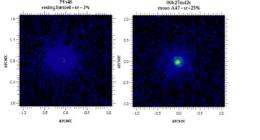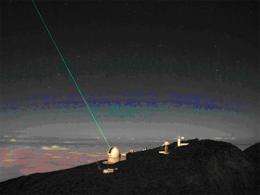To better understand the early universe, adaptive optics technique invented

Adaptive optics makes it possible to remove distortions caused by turbulence in the atmosphere when observing the sky. A major innovation in this field has been achieved by a Franco-British team, including astronomers from the Paris Observatory, CNRS and Universite Paris Diderot. This new technique has for the first time been tested and validated under real conditions using the CANARY prototype mounted on a telescope in La Palma (Spain). It enables scientists to observe very faint astronomical sources over a much wider field of view than was previously possible. In the future, this innovative system may be included in one of the instruments that will equip ESO's European Extremely Large Telescope in Chile. It will make it possible to study the early Universe and better understand its evolution.
Observation of the first stars and galaxies that formed in the early Universe, 800 million years after the big bang, requires a really large telescope. ESO's European Extremely Large Telescope (E-ELT) will have a mirror 42 meters in diameter and will be built at an altitude of 3060 meters in the Atacama Desert in Chile. However, like all its ground-based counterparts, it will inevitably undergo the effects of atmospheric turbulence, which blurs images and reduces their contrast and resolution. To correct such distortions, it will need to be equipped with a technology known as adaptive optics. This works by using a deformable mirror that compensates in real time the early or late arrival of wavefronts of light after they propagate through the atmosphere. But this could only work over a very narrow field of view until now. However, in order to survey the early Universe in detail, astronomers need fields of view that are at least ten times wider.

To achieve such performances, the EAGLE multi-object imaging spectrometer, which should equip the E-ELT, is being developed in France and the UK. Its goal is to make it possible to simultaneously observe 20 distant galaxies within 5 arcminutes (1/6 of the diameter of the full Moon), each one of which will be corrected for atmospheric distortion. However, these primordial galaxies, present in the very first moments of the Universe, are too faint to allow any direct measurement of distortions. Such measurement therefore has to be based on information from the light of the few guide stars present in the field of view, along with the generation of artificial laser guide stars when natural guide stars are insufficient. Under these conditions, compensating turbulence with a single deformable mirror is no longer as efficient as in conventional adaptive optics. Since primordial galaxies have a very small apparent size (approximately one arcsecond), it is only necessary to correct small parts of the images that correspond to the galaxies being observed. It was on this basis that the researchers developed a novel adaptive optics technology called Multi-Object Adaptive Optics (MOAO). This innovative system uses one deformable mirror per target galaxy (20 in all). For each one of them, the mirror is deformed on the basis of measurements taken on all guide stars in the field of view, by means of a tomographic survey of the atmosphere.
Installed on the CANARY prototype, this new technique has for the first time been validated under real on-sky conditions at the 4.2 meter diameter William Herschel telescope in La Palma, Canary Islands, Spain. The measurements were carried out on three guide stars located at a considerable distance from the test star for which the correction of image degradation was modelled. This compensation was applied 150 times per second to the deformable mirror placed in the light beam from the test star. CANARY's performance lived up to expectations: the quality of the image obtained was very close to that measured using a conventional adaptive optics method under similar conditions. Astronomers now benefit from an adaptive optics technique that will enable them to survey a field of view over 10 times larger than those available until now. The next step will be to repeat this experiment with the same prototype, using artificial laser-generated guide stars. If the technology meets expectations, it will equip ESO's E-ELT.
Provided by CNRS

















